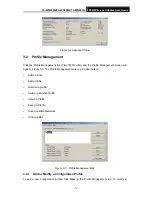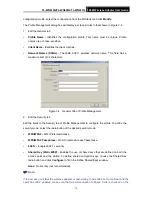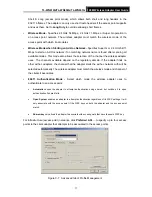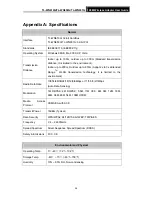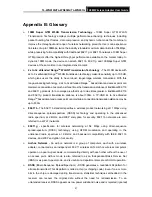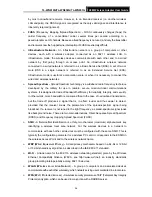
TL-WN610G/TL-WN650G/TL-WN651G
108M Wireless Adapter User Guide
28
by most narrowband receivers. However, to an intended receiver (i.e. another wireless
LAN endpoint), the DSSS signal is recognized as the only valid signal, and interference is
inherently rejected (ignored).
¾
FHSS
(
F
requency
H
opping
S
pread
S
pectrum)
-
FHSS continuously changes (hops) the
carrier frequency of a conventional carrier several times per second according to a
pseudo-random set of channels. Because a fixed frequency is not used, and only the transmitter
and receiver know the hop patterns, interception of FHSS is extremely difficult.
¾
Infrastructure Network -
An infrastructure network is a group of computers or other
devices, each with a wireless adapter, connected as an 802.11 wireless LAN. In
infrastructure mode, the wireless devices communicate with each other and to a wired
network by first going through an access point. An infrastructure wireless network
connected to a wired network is referred to as a Basic Service Set (BSS). A set of two or
more BSS in a single network is referred to as an Extended Service Set (ESS).
Infrastructure mode is useful at a corporation scale, or when it is necessary to connect the
wired and wireless networks.
¾
Spread Spectrum -
Spread Spectrum technology is a wideband radio frequency technique
developed by the military for use in reliable, secure, mission-critical communications
systems. It is designed to trade off bandwidth efficiency for reliability, integrity, and security.
In other words, more bandwidth is consumed than in the case of narrowband transmission,
but the trade off produces a signal that is, in effect, louder and thus easier to detect,
provided that the receiver knows the parameters of the spread-spectrum signal being
broadcast. If a receiver is not tuned to the right frequency, a spread-spectrum signal looks
like background noise. There are two main alternatives, Direct Sequence Spread Spectrum
(DSSS) and Frequency Hopping Spread Spectrum (FHSS).
¾
SSID -
A
S
ervice
S
et
I
dentification is a thirty-two character (maximum) alphanumeric key
identifying a wireless local area network. For the wireless devices in a network to
communicate with each other, all devices must be configured with the same SSID. This is
typically the configuration parameter for a wireless PC card. It corresponds to the ESSID in
the wireless Access Point and to the wireless network name.
¾
WEP
(
W
ired
E
quivalent
P
rivacy)
-
A data privacy mechanism based on a 64-bit or 128-bit
or 152-bit shared key algorithm, as described in the IEEE 802.11 standard.
¾
Wi-Fi -
A trade name for the 802.11b wireless networking standard, given by the Wireless
Ethernet Compatibility Alliance (WECA, see http://www.wi-fi.net), an industry standards
group promoting interoperability among 802.11b devices.
¾
WLAN
(
W
ireless
L
ocal
A
rea
N
etwork) - A group of computers and associated devices
communicate with each other wirelessly, which network serving users are limited in a local area.
¾
WPA
(
W
i-Fi
P
rotected
A
ccess)
-
A wireless security protocol use TKIP (Temporal Key Integrity
Protocol) encryption, which can be used in conjunction with a RADIUS server.

